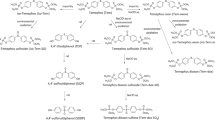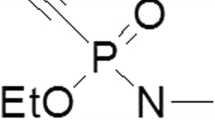Abstract
The ability of three oximes, HI-6, MMB-4 and ICD-467, to reactivate cholinesterase (ChE) inhibited by the organophosphorus compound soman was compared in blood (plasma and erythrocytes), brain regions (including spinal cord) and peripheral tissues of rats. Animals were intoxicated with soman (100 μg/kg, SC; equivalent to 0.9 × LD50 dose) and treated 1 min later with one of these oximes (100 or 200 μmol/kg, IM). Toxic sign scores and total tissue ChE activities were determined 30 min later. Soman markedly inhibited ChE activity in blood (93–96%), brain regions (ranging from 78% to 95%), and all peripheral tissues (ranging from 48.9% to 99.8%) except liver (11.9%). In blood, treatment with HI-6 or ICD-467 resulted in significant reactivation of soman-inhibited ChE. In contrast, MMB-4 was completely ineffective. HI-6 and ICD-467 were equally effective at the high dose. At the low dose ICD-467 treatment resulted in significantly higher plasma ChE than HI-6 treatment, whereas HI-6 treatment resulted in higher erythrocyte ChE than ICD-467 treatment. However, none of these three oximes reactivated or protected soman-inhibited ChE in the brain. In all peripheral tissues (except liver) studied, MMB-4 was not effective. HI-6 reactivated soman-inhibited ChE in all tissues except lung, heart, and skeletal muscle. ICD-467 was highly effective in reactivating ChE in all tissues and afforded a complete recovery of ChE to control levels in intercostal muscle and salivary gland. Oxime treatments did not modify the toxic scores produced by soman. However, treatment with the high dose (200 μmol/kg) of ICD-467 depressed respiration and two of the six rats died in 10 min. These observations indicate that MMB-4 is completely ineffective in protecting and/or reactivating soman-inhibited ChE, HI-6 is an effective ChE reactivator as reported earlier in rats and other species, and the imidazolium oxime ICD-467 is a powerful reactivator of somaninhibited ChE; however, its toxic interactions with soman may not be related to tissue ChE levels.
Similar content being viewed by others
References
Aarseth P, Barstad JAB (1968) Blood-brain barrier permeability in various parts of the central nervous system. Arch Int Pharmacodyn Ther 176: 434–442
Amitai G, Kloog Y, Balderman D, Sokolovsky M (1980) The interaction of bispyridinium oximes with mouse brain muscarinic receptor. Biochem Pharmacol 29: 483–488
Askew BM (1956) Oximes and hydroxamic acids as antidotes in anticholinesterase poisoning. Br J Pharmacol 11: 417–423
Bajgar J (1974) The effect of cholinesterase reactivators on brain acetylcholinesterase of animals poisoned by isopropyl methylphosphonofluoridate. Sb Ved Pr Lek Fak Karlovy Univ 17: 165–198
Bajgar J, Patocka J, Jakl A, Hrdina V (1975) Antidotal therapy and changes of acetylcholinesterase activity following isopropyl methylphosphonofluoridate intoxication in mice. Acta Biol Med Germ 34: 1049–1055
Berry WK, Davies DR (1970) The use of carbamates and atropine in the protection of animals against poisoning by 1,2,2-trimethylpropylmethylphosphonofluoridate. Biochem Pharmacol 19: 927–934
Boskovic B (1981) The treatment of soman poisoning and its perspectives. Fundam Appl Toxicol 1: 203–213
Boskovic B, Kovacevic V, Jovanovic D (1984) PAM-2 Cl, HI-6, and HGG-12 in soman and tabun poisoning. Fundam Appl Toxicol 4: S106-S115
Clement JG (1979 a) Pharmacological actions of HS-6, an oxime, on the neuromuscular junction. Eur J Pharmacol 53: 135–141
Clement JG (1979 b) Efficacy of pro-2-PAM (N-methyl-1,6-dihydropyridine-2-carbaldoxime hydrochloride) as a prophylaxis against organophosphate poisoning. Toxicol Appl Pharmacol 47: 305–311
Clement JG (1981) Toxicology and pharmacology of bispyridinium oximes — insight into the mechanism of action vs soman poisoning in vivo. Fundam Appl Toxicol 1: 193–202
Clement JG (1982) HI-6: Reactivation of central and peripheral acetylcholinesterase following inhibition by soman, sarin and tabun in vivo in the rat. Biochem Pharmacol 31: 1283–1287
Clement JG (1992) Central activity of acetylcholinesterase oxime reactivators. Toxicol Appl Pharmacol 112: 104–109
De Jong LPA, Wolring GZ (1980) Reactivation of acetylcholinesterase inhibited by l,2,2′-trimethylpropylmethylphosphonofluoridate (soman) with HI-6 and related oximes. Biochem Pharmacol 29: 2379–2387
Dunn MA, Sidell FR (1989) Progress in medical defense against nerve agents. JAMA 262: 649–652
Ellman GL, Courtney KD, Andres V, Featherstone RM (1961) A new and rapid colorimetric determination of acetylcholinesterase activity. Biochem Pharmacol 7: 88–95
Eyer P, Hagedorn I, Klimmek R, Lippstreu P, Loffler M, Oldiges H, Spohrer U, Steidl I, Szinicz L, Worek F (1992) HLo-7 dimethanesulfonate, a potent bispyridinium-dioxime against anticholinesterases. Arch Toxicol 66: 603–621
Fleisher JH, Harris LW (1965) Dealkylation as a mechanism for aging of cholinesterase after poisoning with pinacolylmethylphosphonofluoridate. Biochem Pharmacol 14: 641–650
Fleisher JH, Harris LW, Murtha EF (1967) Reactivation of pyridinium aldoxime methochloride (PAM) of inhibited cholinesterase activity in dogs after poisoning with pinacolylmethylphosphonofluoridate (soman). J Pharmacol Exp Ther 156: 345–351
Fleisher JH, Harris LW, Miller GR, Thomas NC, Cliff WJ (1970) Antagonism of sarin poisoning in rats and guinea pigs by atropine, oximes, and mecamylamine. Toxicol Appl Pharmacol 16: 40–47
Frawley JP, Hagan EC, Fitzhugh OG (1952) A comparative pharmacological and toxicological study of organic phosphate-anticholinesterase compounds. J Pharmacol Exp Ther 105: 156–165
Gordon JJ, Leadbeater L, Maidment MP (1978) The protection of animals against organophosphate poisoning by pretreatment with a carbamate. Toxicol Appl Pharmacol 43: 207–216
Groff WA, Kaminskis A, Ellin RI (1976) Interconversion of cholinesterase enzyme activity units by the manual pH method and a recommended automated method. Clin Toxicol 9: 353–358
Hamilton MG, Lundy PM (1989) HI-6 therapy of soman and tabun poisoning in primates and rodents. Arch Toxicol 63: 144–149
Hanin I, Massarelli R, Costa E (1970) Acetylcholine concentrations in rat brain: diurnal oscillation. Science 170: 341–342
Harris LW, Stitcher DL (1983) Reactivation of VX-inhibited cholinesterase by 2-PAM and HS-6 in rats. Drug Chem Toxicol 6: 235–240
Harris LW, Stitcher DL, Heyl WC (1981) Protection and induced reactivation of cholinesterase by HS-6 in rabbits exposed to soman. Life Sci 29: 1747–1753
Harris LW, Anderson DR, Lennox WJ, Woodard CL, Pastelak AM, Vanderpool BA (1990) Evaluation of several oximes as reactivators of unaged soman-inhibited whole blood acetylcholinesterase in rabbits. Biochem Pharmacol 40: 2677–2682
Heilbronn E, Tolagen B (1965) Toxogonin in sarin, soman and tabun poisoning. Biochem Pharmacol 14: 73–77
Hobbiger F (1957) Protection against the lethal effects of organophosphates by pyridine-2-aldoxime methiodide. Br J Pharmacol 12: 438–446
Hobbiger F, Sadler PW (1959) Protection against lethal organophosphate poisoning by quaternary pyridine aldoximes. Br J Pharmacol 14: 192–201
Inns RH, Leadbeater L (1983) The efficacy of bispyridinium derivatives in the treatment of organophosphonate poisoning in the guinea-pig. J Pharm Pharmacol 35: 427–433
Jimmerson VR, Shih T-M, Mailman RB (1989) Variability in soman toxicity in the rat: Correlation with biochemical and behavioral measures. Toxicology 57: 241–254
Joiner RL, Dill GS, Hobson DW, Olson CT, Feder PI, Menton RG, Kiser RC (1989) Evaluating the efficacy of antidote drug combinations against soman or tabun toxicity in the rabbit. Final Report. USAMRDC Contract DAMD17-83-C-3129, Task 87-35. DTIC# ADA216386, Battelle Memorial Institute, Columbus, OH
Jovanovic D, Randjelovic S, Joksovic D (1990) A case of unusual suicidal poisoning by the organophosphorus insecticide dimethoate. Hum ExpToxicol 9: 49–51
Jovic RC (1974) Correlation between signs of toxicity and some biochemical changes in rats poisoned with soman. Eur J Pharmacol 25: 159–164
Kewitz H, Wilson IB (1956) A specific antidote against lethal alkyl phosphate intoxication. Arch Biochem Biophys 60: 261–263
Koplovitz I, Stewart JR (1988) Novel imidazolium oximes as improved nerve agent antidotes. USAMRICD-TR-88-06 (AD# A198 242). US Army Medical Research Institute of Chemical Defense, Aberdeen Proving Ground, MD
Koplovitz I, Stewart JR (1992) Efficacy of oxime plus atropine treatment against soman poisoning in the atropinesterase-free rabbit. Drug Chem Toxicol 15: 117–126
Kuhnen-Clausen P, Hagedorn I, Gross G, Bayer H, Hucho F (1983) Interactions of bisquaternary pyridine salts (H-oximes) with cholinergic receptors. Arch Toxicol 54: 171–177
Kusic R, Jovanovic D, Randjelovic S, Joksovic D, Todorovic V, Boskovic B, Jokanovic M, Vojvodic V (1991) HI-6 in man: efficacy of the oxime in poisoning by organophosphorus insecticides. Hum Exp Toxicol 10: 113–118
Ligtenstein DA, Moes GWH, Kossen SP (1988) In vivo distribution of organophosphate antidotes: autoradiography of [14C]HI-6 in the rat. Toxicol Appl Pharmacol 92: 324–329
Lundy PM, Shih T-M (1983) Examination of the role of central cholinergic mechanisms in the therapeutic effects of HI-6 in organophosphate poisoning. J Neurochem 40: 1321–1328
Lundy PM, Hand BT, Broxup BR, Yipchuck G, Hamilton MG (1990) Distribution of the bispyridinium oxime [14C]HI-6 in male and female rats. Arch Toxicol 64: 377–382
Oldiges H, Schoene K (1970) Pyridinium and imidazolium salts as antidotes for soman and paraoxon poisoning in mice. Arch Toxicol 26: 293–305
Owasoyo JO, Okonmah AD, Soliman KFA, Walker CA (1980) Circadian variation in the acetylcholinesterase activity of specific rat brain areas. J Interdiscipl Cycle Res 11: 251–256
Saito Y, Yamashita I, Yamazaki K, Okada F, Satomi R, Fujieda T (1975) Circadian fluctuation of brain acetylcholine in rats. I. On the variations in the total brain and discrete brain areas. Life Sci 16: 281–288
Shih T-M, Whalley CE, Valdes JJ, Lundy PM, Lockwood PA (1986) Cholinergic effects of HI-6 in soman poisoning. In: Hanin I (ed) Dynamics of cholinergic function. Plenum, New York, pp 767–779
Shih T-M, Whalley CE, Valdes JJ (1991) A comparison of cholinergic effects of HI-6 and pralidoxime-2-chloride (2-PAM) in soman poisoning. Toxicol Lett 55: 131–147
Talbot BG, Anderson DR, Harris LW, Yarbrough LW, Lennox WJ (1988) A comparison of in vivo and in vitro rates of aging of somaninhibited erythrocyte acetylcholinesterase in different animal species. Drug Chem Toxicol 11: 289–305
Taylor P (1990) Anticholinesterase agents. In: Gilman AG, Rall TW, Nies AS, Taylor P (eds) Goodman and Gilman's the pharmacological basis of therapeutics (eighth edition). Macmillan, New York, pp 130–149
Valdes JJ, Shih T-M, Whalley CE (1985) Competitive binding of the oximes HI-6 and 2-PAM with regional brain muscarinic receptors. Biochem Pharmacol 34: 2815–2818
van Helden HPM, van der Wiel HJ, de Lange J, Busker RW, Melchers BPC, Wolthuis OL (1992) Therapeutic efficacy of HI-6 in somanpoisoned marmoset monkeys. Toxicol Appl Pharmacol 115: 50–56
Weichselbaum TE (1946) Accurate and rapid method for determination of proteins is small amounts of blood serum and plasma. Am J Clin Pathol Tech Sect 10: 40–49
Author information
Authors and Affiliations
Additional information
The experiments reported here were conducted according to the “Guide for the Care and Use of Laboratory Animals” (1985), as prepared by the Committee on Care and Use of Laboratory Animals, National Research Council, NIH Publication No. 85-23. The opinions or assertions contained herein are the private views of the author and are not to be construed as official or as reflecting the views of the Department of the Army or the Department of Defense
Rights and permissions
About this article
Cite this article
Shih, T.M. Comparison of several oximes on reactivation of soman-inhibited blood, brain and tissue cholinesterase activity in rats. Arch Toxicol 67, 637–646 (1993). https://doi.org/10.1007/BF01974071
Received:
Accepted:
Issue Date:
DOI: https://doi.org/10.1007/BF01974071




